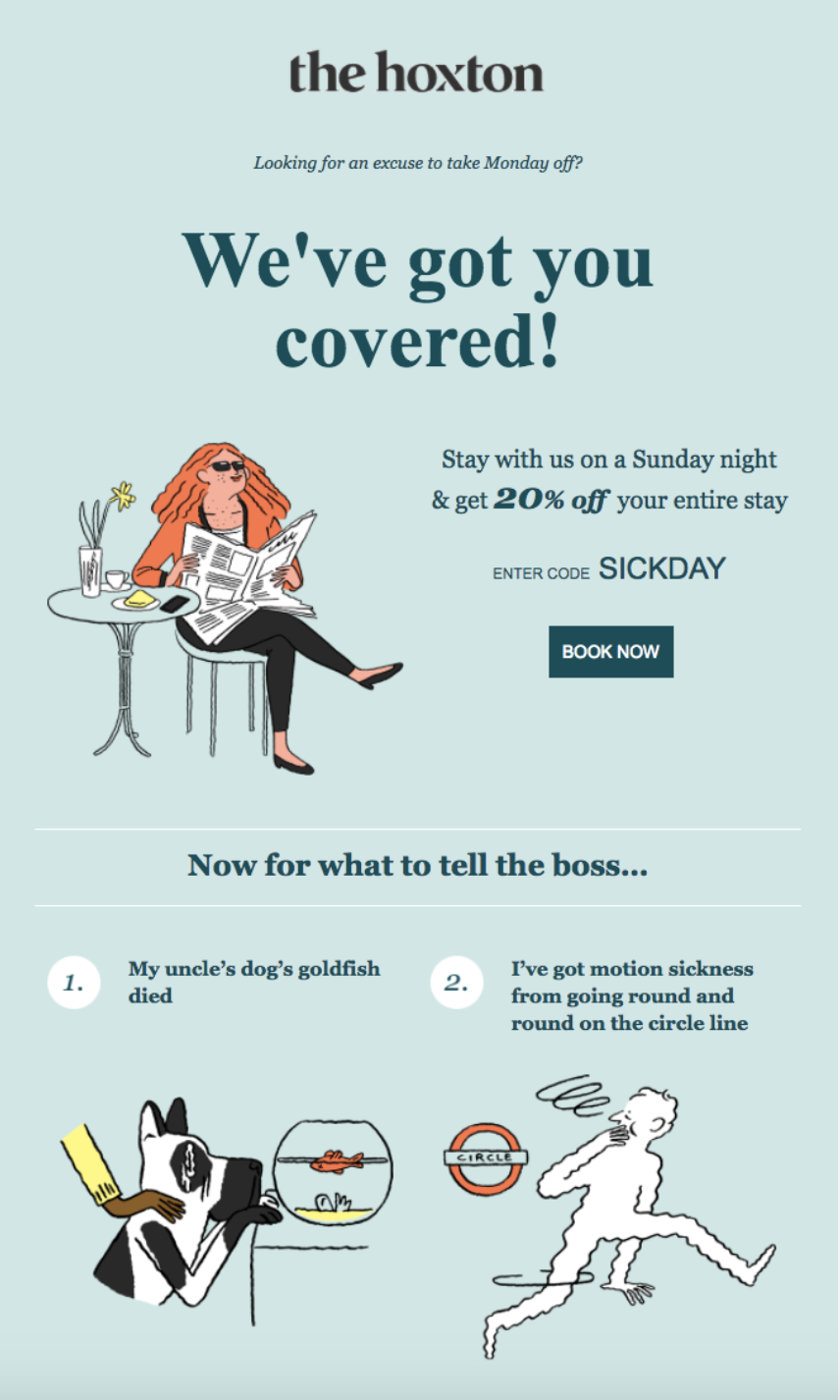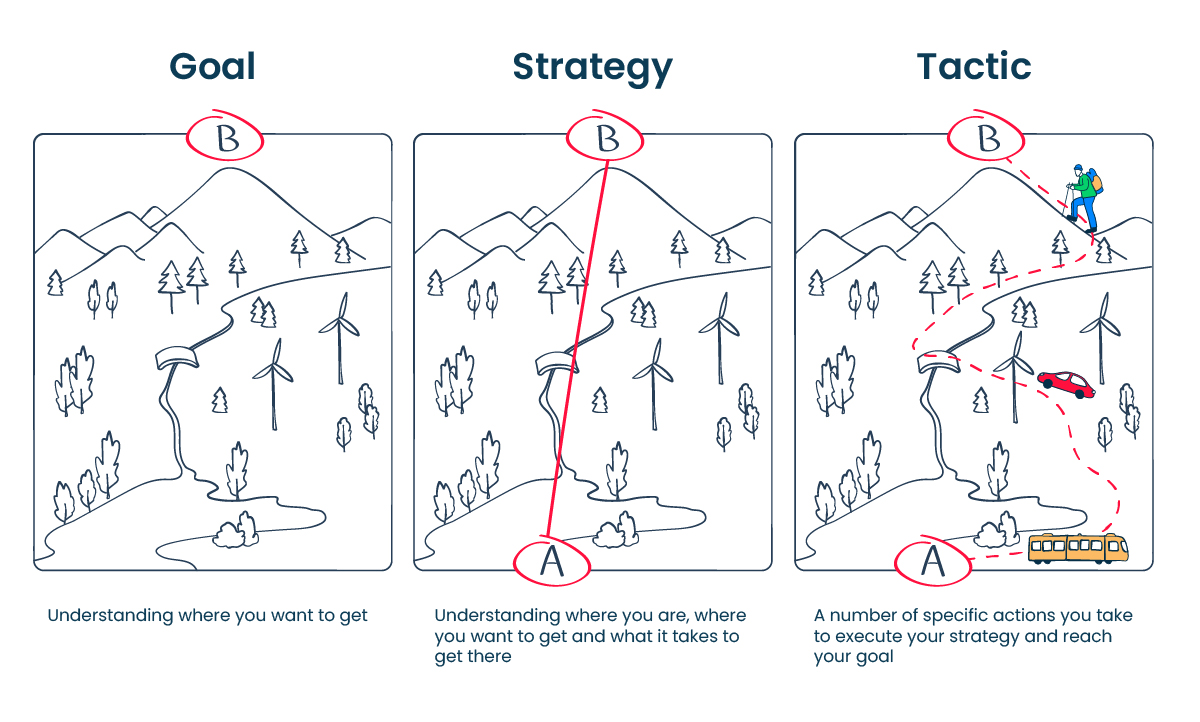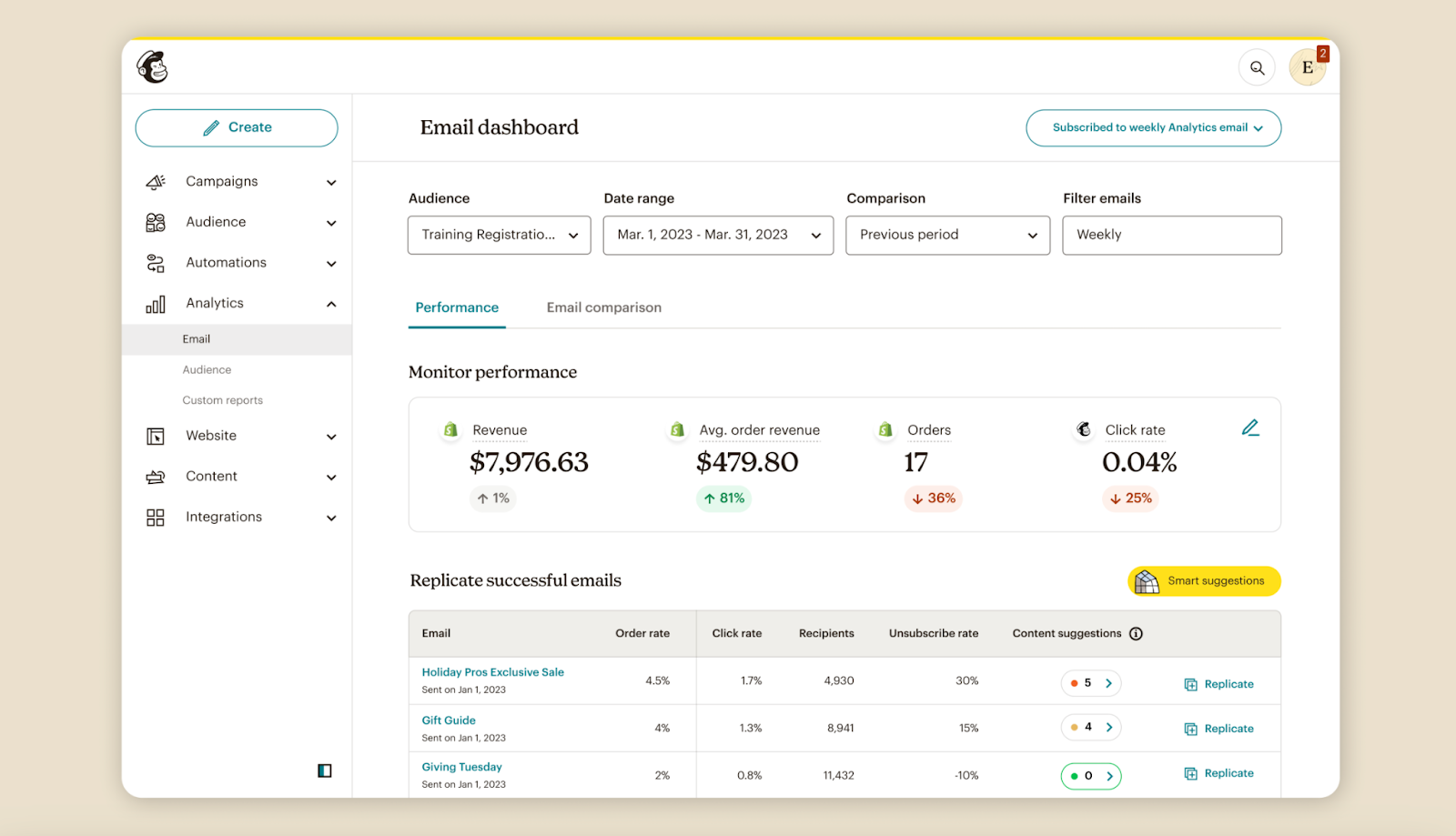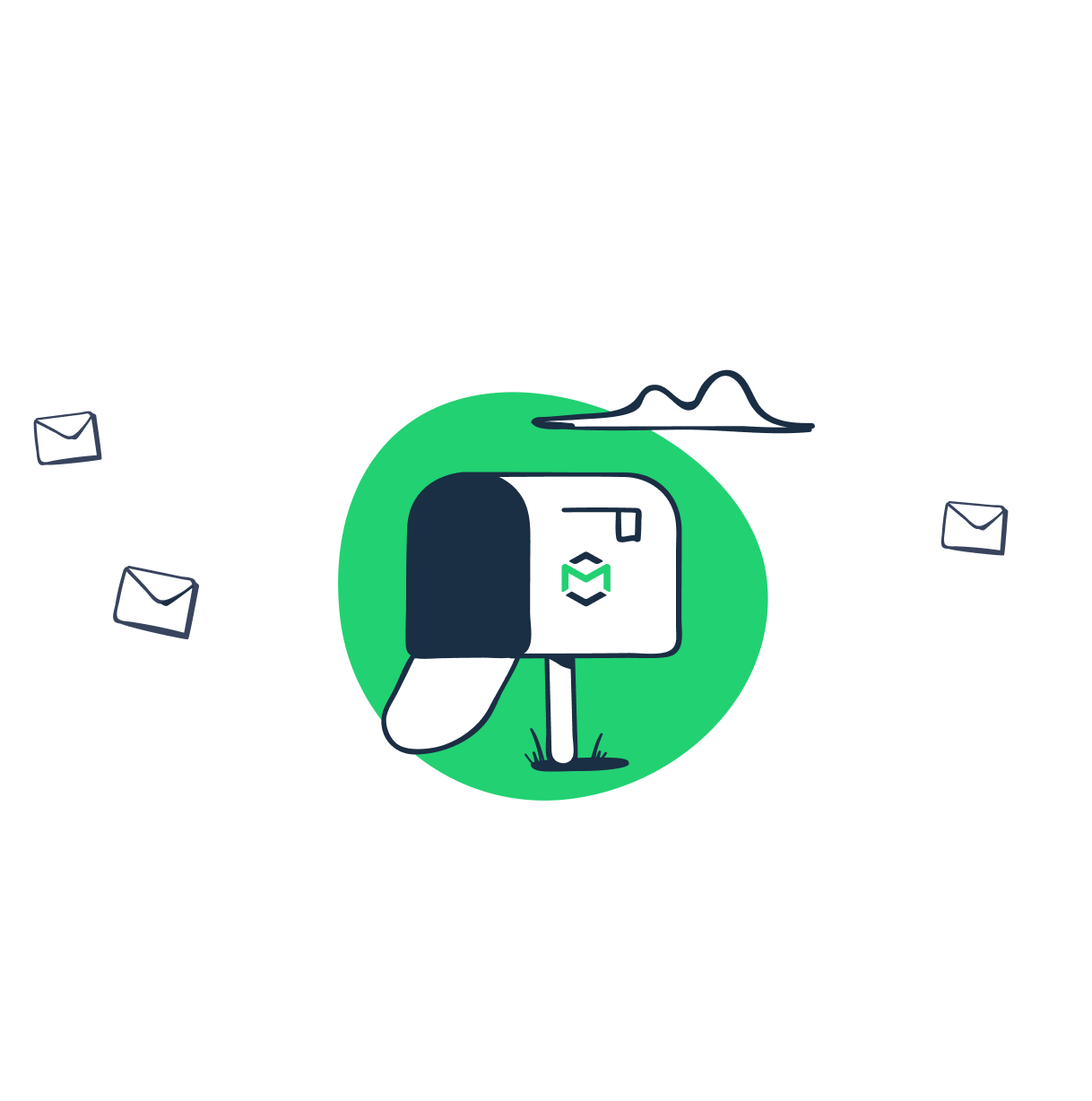Email marketing is a vital tool for businesses of all sizes, and hotels are no exception. A well-crafted strategy can help hoteliers acquire new customers, drive more bookings, build a lasting relationship with their guests, and increase their revenue.
This article defines email marketing for hotels and provides examples, useful tips, and software recommendations to help you build a successful strategy.
What is email marketing for hotels?
Email marketing for hotels is a type of email marketing designed to increase direct bookings, enhance the guest experience, and foster long-term loyalty through personalized emails. It focuses on nurturing guest relationships before, during, and after their stay.
Email marketing for hotels has many unique characteristics due to the specific relationships hotels have with clients. Unlike other service companies, hotels experience irregular bookings (a one-night stay, long vacation, weekend trip) for various reasons (business trips, leisure travel, events) often from the same guest. This means the same person can have different needs each time they book. For example, a guest might choose your hotel for a business trip but prefer another property for a family vacation.
Such shifting needs are hard to cover. This is why hotels tend to collect all possible information about their guests, offer flexible incentives that appeal to different types of travelers, unintrusively nurture leads with personalized content, seasonal offers, and local recommendations, and humbly remind subscribers of their great services once or twice a month. These emails can also highlight modern amenities your property offers, including self-check-in options or a hotel IPTV system, keeping guests informed and enhancing their overall experience.
Hotel email marketing examples
The most common emails the hotels send are:
- Welcome emails – to greet new guests, offer perks, and nudge them to complete their first booking.
- Booking confirmations – to provide essential stay details and simplify the arrival process.
- Special offers and holiday promotions – to encourage direct bookings with personalized deals, time-sensitive discounts, or seasonal offers around holidays or local celebrations.
- Exclusive offers – to reward loyal guests or members with discounts or unique perks that aren’t available publicly.
- Post-stay emails – to gather feedback, request reviews, and promote loyalty programs.
- Location newsletters – to showcase specific destinations, highlight attractions, local events, and recommendations, and inspire future bookings.
- Seasonal hotel newsletters – to share travel tips, exclusive packages, and relevant updates, reminding subscribers of the hotel’s brand.
Numa – Welcome Email
Welcome emails are a great way to make a strong first impression and start building a long-term relationship with guests. These emails typically greet new subscribers, highlight membership perks, and encourage direct bookings.
Look at this welcome email from Numa, a hospitality company that offers boutique accommodations across Europe. The message starts with a warm, personalized greeting and introduces an impressive list of perks.
This email serves its purpose by offering flexible incentives that fit different travel needs. For example, free drinks and snacks may attract leisure travelers, while early check-in and late check-out appeal to business travelers on tight schedules. The 10% discount and long-stay savings show that Numa values both first-time guests and loyal customers who return for extended stays.
What we like:
- Personalized greeting. Addressing the recipient by name makes the email feel more personal and welcoming.
- The message is short and to the point.
- Structured list of flexible member perks outlined with checkboxes so that it’s easy for readers to scan quickly and understand what they’re getting.
- The call-to-action (CTA) is clear and action-oriented.
What could be improved:
- Too many footnotes. The disclaimers about perks (availability and restrictions) are necessary but could be better integrated into the design to keep the email clean and uncluttered.
- The email doesn’t mention which cities Numa operates in or what sets them apart from other accommodation options.
The Hoxton – Special Offer
Special offer emails are a great way to attract new customers and motivate existing ones to book their stay. These can be couples or children discounts, voucher codes, discounts on a specific location, free spa treatments or room type upgrades. Such offers can increase your traffic on slow weekends and seasons. You could make them targeted to specific audience segments, such as bachelorettes, couples, business travelers, or school children.
Below you can see a great example of the special offer email from The Hoxton Hotel.

What we like:
- The copy is well-crafted and has a humorous tone, matching the industry and the vibe of the email.
- The illustrations are smart and eye-catching.
- The discount is generous.
- The email includes clear instructions on what the user should do to get a discount.
What could be improved:
- On the technical side, the language attribute isn’t clearly defined, which may hinder the transcription of the message if English isn’t the default language for the users’ screen reader.
- Table roles aren’t clearly defined.
Ace Hotel Pittsburgh – Seasonal Events and Occasions
Seasonal events and occasions can be part of your email newsletter campaigns or be launched separately, depending on the upcoming holidays. Hotel marketers can use these emails to promote their events and provide a sneak peek into the activities that will be happening during the season.
Event calendars can be made into targeted emails with personalized recommendations for audience segments that are planning their stay in a specific timeslot. Alternatively, they can be general and list different types of activities to captivate the attention of a wider audience.
Ace Hotel Pittsburgh takes a general approach and offers various events that accommodate people with different interests.
What we like:
- The email is informational and includes small descriptions and useful links for each event.
- The design is simple and includes one banner and one image.
- The structure and headings are clearly defined.
What could be improved:
- The CTAs aren’t clear and concise.
- The email contains around 20 links (maybe more). The rule of thumb is to keep the number of links under 5 to avoid damaging sender reputation and email deliverability.
Airbnb – Holiday Promotion
Holiday promotion emails help hotels and accommodations attract guests during peak travel seasons by offering special discounts, exclusive perks, or themed experiences. These emails create urgency, encourage direct bookings, and help hotels stand out in a competitive market.
A holiday promotion email usually has:
- A festive, engaging subject line/heading
- A time-sensitive offer to create urgency
- Personalized recommendations based on past stays or browsing history
- High-quality visuals of seasonal decor and cozy accommodations
- A clear CTA to nudge the deal.
Look at this holiday promotion email from Airbnb that encourages users to explore seasonal stays with exclusive offers.
What we like:
- An intriguing heading that promises a personal gift.
- A time-sensitive discount that encourages quick bookings.
- Strong visuals with high-quality images that make the listings stand out and inspire travel.
- Clear CTAs that guide users toward booking their perfect holiday stay with a 5% discount.
What could be improved:
- The email lacks a personal greeting that makes the message feel more personal.
- The recommendations in the email seem random and aren’t based on past stays or search history, missing an opportunity to make the offer more compelling.
Location Newsletter – Ace Hotel Toronto
Location newsletters help hotels highlight their destinations and showcase local attractions. These emails provide insights into the city or region, featuring must-visit spots, hidden gems, and seasonal events to help potential guests discover what makes a location special.
Ace Hotel Toronto uses this approach to spotlight its location and nearby attractions to help guests experience the city’s unique vibe.
What we like:
- Short but vivid neighborhood description that gives readers a feel for the area.
- High-quality images highlight the beauty of the hotel interior and bar.
- Well-balanced layout with brief yet informative text and stunning visuals.
What could be improved:
- The email only features the hotel, missing an opportunity to showcase the surrounding area.
- There’s no personal greeting or tailored details, which makes the email feel generic rather than crafted for the subscriber.
Benefits of hospitality email marketing
Email marketing can bring you many benefits if done right (I explain what “right” means here).
Let’s take a closer look at the reasons why you might want to start investing in email marketing or invest more than before.
High ROI
Email marketing is still one of the most cost-effective marketing strategies for hotels. Thanks to its low costs, automation, and precise audience targeting, email outperforms many other marketing strategies in terms of engagement and conversions.
Unlike ad-driven marketing channels that require ongoing budget allocation, email lets you build and maintain relationships with guests at a fraction of the cost. Automated workflows—such as pre-stay upsells, post-stay feedback requests, and exclusive return offers—help hotels generate revenue from existing customers while keeping acquisition costs low. Plus, with direct booking incentives and personalized offers, hotels can reduce their reliance on online travel agencies (OTAs), increasing profitability per reservation.
Direct communication and guest engagement
Email is a unique channel that lets you communicate directly with potential guests without relying on third-party platforms like OTAs, social media platforms, and metasearch engines.
Whether it’s pre-arrival emails with instructions, post-stay surveys, or loyalty program updates, email ensures guests receive critical information right when they need it.
You can also use emails to engage with your past, present, and future guests and nurture loyal relationships with seasonal promotions, travel inspiration, and exclusive deals.
Customer loyalty and retention
Retaining a guest is much cheaper than acquiring a new one.
Email marketing lets you create an engaging but non-intrusive loyalty program with exclusive perks, membership rewards, and personalized offers. At the same time, automated email sequences allow you to re-engage past guests, periodically remind them of your hotel, and incentivize long-term loyalty and repeat bookings.
Booking recovery
Abandoned bookings are a persistent pain in the hospitality sector, with many guests leaving the reservation process midway.
Cart abandonment reminders—widely used in e-commerce—can also work effectively in hospitality, reminding users to complete their booking.
Personalized follow-ups with limited-time discounts, social proof (such as reviews, video guides, or photos), and an easy-to-access booking link can significantly increase conversion rates.
Effective customer lifecycle management
Guests anticipate emails from you when they book and before they arrive. They also don’t mind post-stay emails requesting feedback and reviews.
When composed properly, these emails can be more than just a formality. They help you subtly manage the guest experience and leave a positive impression so your future promotional emails feel familiar, welcomed, and not out of the blue.
How to do email marketing for hotels
Hotels deal with irregular bookings, varied guest needs, and different travel motivations every time someone stays. To make email marketing work, you need to understand your guests, tailor content to their journey, and keep them engaged without overwhelming their inbox. Here’s how to create an email marketing strategy that works:
Define the goal
Your email marketing strategy should always begin with a clearly defined goal that will act as your guiding star for all future activities.

The goal—whether it’s increasing bookings, re-engaging past guests, or reducing booking abandonment—needs to be specific, measurable, achievable, relevant, and time-bound (SMART). Without these qualities, it risks becoming wishful thinking or an unrealistic dream.
Here’s what it may look like:
Re-engage past guests
Goal: Increase repeat bookings by 7% in six months by sending a three-part re-engagement email series to guests who haven’t stayed in over a year.
- Specific – Focuses on increasing repeat bookings from past guests.
- Measurable – Targets a 10% increase within six months.
- Achievable – Uses a proven re-engagement strategy with personalized hotel email marketing campaigns.
- Relevant – Aligns with the broader goal of improving customer retention and loyalty.
- Time-bound – Sets a clear deadline of six months to achieve results.
Gather quality contacts
Collecting emails in the hotel industry can be tricky since people don’t often subscribe before their first booking. Unlike other businesses, hotels need to use situational and value-driven methods to gather quality contacts without being intrusive.
Here are some of the most effective ways hotels collect emails:
- During the booking process. Add an opt-in option for newsletters or exclusive offers when guests are filling out their booking details. Sweeten the deal with perks like future discounts or upgrades.
- Via loyalty programs. Encourage sign-ups to your loyalty program, which naturally requires an email address and provides an easy way to engage guests over time.
- In exchange for Wi-Fi access. Guests are often happy to share their email in return for free Wi-Fi during their stay. If your hotel has a bar or restaurant, you can also capture emails from non-guests who stop by for food or drinks.
- At check-in or check-out. Offer exclusive deals or discounts to guests who sign up at the front desk during their visit.
- Through feedback requests. Include an opt-in box when sending post-stay feedback or review requests to satisfied guests.
- On your hotel website. Use a pop-up or form offering a compelling reason to subscribe, like a local travel guide, event updates, or seasonal offers.
- Through social media. Run giveaways or promotions requiring participants to provide their email addresses, like a chance to win a free stay.
The main rule here is to use legal ways of collecting emails. This means that you should not purchase an email list under any circumstances. Not only is it illegal in many regions (EU, Canada, Australia), but these lists are also filled with unengaged recipients who don’t expect to hear from you and are likely to mark your emails as spam. Worse, they often contain spam traps, which will get you blacklisted, making it impossible for ESPs to deliver your emails.
Instead, focus on organic email collection methods with double opt-in registration. This process adds a verification step where users must confirm their email before being added to your list. It filters out bots, fake addresses, and uninterested sign-ups, leaving you with a high-quality, engaged audience that is more likely to interact with your emails and book a stay.
Alternatively, you can hire an agency that specializes in organic email collection and will gather engaged subscribers from your target audience.
You can find out more on how to keep your email list healthy and up-to-date in our dedicated guide.
Choose the right email marketing software
Your email marketing software should help you run effective campaigns, manage guest communication, and drive bookings. Below, I list the main criteria to consider when comparing available options for your hotel business:
Deliverability
Deliverability rate is the ratio of sent emails to those that actually reach recipients. The lower the rate, the more money you waste.
To evaluate platforms, you can browse G2 and Capterra for user complaints or check independent comparisons—like those conducted by Email Tool Tester or our own tests.
We checked various email-sending services using identical email templates, shared IP addresses, and the GlockApps tool to track inbox placement. Here’s how they performed:
| Email delivery services | Email placement results |
| Mailtrap | Inbox: 78.8% Tabs: 4.8% Spam: 14.4% Missing: 2.0% |
| Amazon SES | Inbox: 77.1% Tabs: 1.9% Spam: 20.0% Missing: 1.0% |
| Mailgun | Inbox: 71.4% Tabs: 3.8% Spam: 23.8% Missing: 1.0% |
| SendGrid | Inbox: 61.0% Tabs: 1.0% Spam: 17.1% Missing: 20.9% |
| Postmark | Inbox:83.3% Tabs: 1.0% Spam: 14.3% Missing: 0.9% |
For a detailed analysis, methodology explanation, and comprehensive results, check our email deliverability comparison blog post.
Apart from deliverability, consider:
- Scalability. Your software should support high-volume sending and offer flexible pricing plans so you can scale as your subscriber list grows.
- Automation and segmentation. Look for tools that allow drip campaigns, behavior-triggered emails, and audience segmentation to send personalized offers based on guest preferences.
- Email design and templates. Choose a platform with drag-and-drop builders, pre-designed templates, and an HTML editor to create professional-looking emails.
- Integration with hotel management tools. The software should connect with hospitality CRM software, booking systems, and guest management platforms to sync data and automate workflows.
- Analytics and reporting. Choose a platform with a robust analytics dashboard that tracks email open rates, click-through rates, conversions, bounce rates, and spam complaints to help measure and optimize each email’s performance.
- User experience. A simple, intuitive interface with good onboarding, tutorials, and customer support will help your team get started quickly.
- Pricing and plans. Look for transparent pricing, free trials, and essential features at lower tiers to avoid unexpected costs.
If you want to see our top picks for the best email sending software for hotels, jump to this section.
Plan your content and start sending
Start with a content plan. Outline your email topics, formats, and scheduling months in advance. This way, your emails will be consistent, aligned with seasonal trends, and targeted to your audience.
When crafting hotel email content, focus on what matters to your guests:
- Solve their problems – provide travel tips, highlight special deals, and address common booking concerns.
- Keep it readable – use clear language, short paragraphs, and scannable formatting.
- Make it valuable – share local insights, exclusive offers, or loyalty perks that benefit the recipient.
- Personalize when possible – use guest preferences, past stays, and behavior data to tailor content.
- Build trust – back up offers with social proof, such as reviews, testimonials, or guest stories.
- Make it pretty – use high-quality videos and images that showcase your hotel’s atmosphere, digital menu boards, amenities, and local attractions.
Learn from each campaign
Every campaign is a source of valuable information to refine your hotel email marketing strategy. Track email marketing metrics such as open, click-through rates, and conversions to see what drives action.
If engagement drops, tweak your subject lines, content, or send times. If bookings spike after a certain type of email, double down on what works.
Use A/B testing to experiment, analyze the data, and continuously improve your campaigns. Digital marketing isn’t set-and-forget—it’s a process of learning and optimizing.
Cost of email marketing for hotels
The costs of your email marketing efforts can vary based on many factors. Let’s consider them and count the expenses:
| Expense | Details | Cost |
| Email marketing software | Pricing depends on your email list size, dispatch frequency, and features like automation, segmentation, and analytics | $50 to $1,000+ per month, with higher tiers for large hotel chains |
| Dedicated IPs | If you’re sending high volumes, a dedicated IP may improve deliverability and sender reputation | $20–$100 per month |
| Labor costs | Running campaigns in-house requires marketers, designers, and copywriters. Hiring an agency can cost significantly more. | $2,500–$10,000+ per month for agencies; Freelancers charge $20–$150 per hour |
| CRM and analytics | Integrating email with guest management systems can add additional monthly costs, depending on the tool | $50–$200 per month |
| Compliance tools | GDPR and other regulations may require additional investments for data protection software | $20–$200 per month |
As you can see, your email marketing can cost anywhere from $50 to over $10,000 per month.
The good news is that you can (and should) start small and increase your budget as your email list grows and you get positive returns from your campaigns.
But even at the higher end, email marketing remains more cost-effective than PPC or OTA commissions—and, more importantly, delivers a significantly higher ROI.
Best email marketing software for hotels
In the previous section, I covered the key factors to consider when choosing an email marketing tool. If you need a refresher, feel free to revisit it. If not, let’s dive into the best email marketing software for hotels.
Mailtrap
Mailtrap is an email delivery platform for marketing, mass, and transactional emails with industry-leading analytics. It allows you to create visually engaging emails, test them in a safe environment, ensure they reach email subscribers’ inboxes, and analyze performance with advanced reporting. This all-in-one solution is ideal for hotels that want to streamline their email marketing efforts.
Mailtrap features an intuitive template builder with drag-and-drop functionality and an HTML editor, pre-designed templates, and a simple campaign scheduler for quick automation. Its advanced analytics dashboard offers visual graphs to track key deliverability metrics, while detailed mailbox provider reports help optimize campaigns and maintain a strong sender reputation.
Mailtrap’s free plan supports 1,000 emails per month, enough for small hotels testing email marketing or sending basic transactional emails. For higher volumes, paid plans start at $15/month for 10K emails, allowing hotels to scale campaigns without contact limits. Find full plan details here.
Mailchimp
Mailchimp is a popular choice among hotels because of its affordable pricing and feature-rich platform. It offers customizable email templates, audience segmentation, and automation capabilities. Mailchimp’s user-friendly interface makes it easy for hotels to design and send professional email campaigns without extensive technical knowledge.

The free plan covers basic templates, limited automation, and up to 500 contacts, making it useful for small-scale campaigns or testing. Paid plans unlock more advanced features for hotels that need larger contact lists, enhanced automation, and detailed analytics.
MailerLite
MailerLite is a user-friendly email marketing platform that helps hotels create visually appealing email campaigns, landing pages, and pop-ups. With an intuitive drag-and-drop editor, built-in automation, and advanced segmentation, hotels can easily send personalized offers, booking confirmations, and guest feedback requests. A standout feature of MailerLite is email-embedded surveys, which allow you to collect hotel guests’ reviews directly within emails.
MailerLite offers a free plan for up to 1,000 contacts and 12,000 emails per month, including essential tools for automation and landing pages. Paid plans start at $9 per month for 500 contacts with unlimited emails.
ActiveCampaign
ActiveCampaign is an email marketing platform with advanced automation and CRM integration. It allows hotels to segment audiences, personalize guest communication, implement scoring, and behavioral tracking to send targeted emails based on booking history, preferences, and past interactions.
ActiveCampaign doesn’t offer a free plan. Paid tiers start at $15/month for basic email automation, while more advanced plans ($49–$149/month) include CRM, predictive sending, and in-depth analytics for complex hotel marketing needs.
How to send an email marketing campaign
Ready to send your first special offer or holiday promotional campaign? Let me walk you through the process using Mailtrap. Don’t worry, the steps are easy to complete within an hour once your domain is verified.
Set up your Mailtrap account and verify your domain
First, create a Mailtrap account. After that, open the “Sending Domains” section and add the domain from which you will send emails, such as your company’s website domain, for verification.
Next, go to your domain provider (e.g., GoDaddy) and paste the DNS records provided by Mailtrap. You can find the DNS settings in your provider’s dashboard under “Manage DNS.”
After updating the records, click “Verify All” in Mailtrap and wait for confirmation that your domain has been verified.
Import your contacts list
Open the Mailtrap web app and go to the “Contacts” section. Select “Import Contacts” and upload your email list in CSV format.
Make sure that the fields are mapped correctly so Mailtrap can process them without any issues.
Before uploading your email list, clean it up by eliminating inactive, invalid, and duplicate email addresses. This way, your email deliverability rate will be higher.
Create your email template
Navigate to the “Templates” tab. You can either create your email from scratch using the drag-and-drop builder or an HTML editor, or choose a pre-designed template and personalize it to suit your needs.
The Mailtrap’s builder offers helpful features, such as AI-driven copy suggestions and a free image library, to help you craft the ideal message. When you’re finished, click “Save” or “Send Test” to send a test email to your inbox for review.
Merge tags won’t function in test emails as they are only sent to your address, not the entire email list. So, there’s no need to worry about this at the moment.
Set up and schedule your campaign
When your email design is created and checked, click on “Email Marketing” in the left sidebar, then select “Create New Campaign.”
Enter your campaign details and click “Continue.” Select the template you created and add merge tags to personalize it.
Choose the email list you want to send your email to. That’s it—your campaign is ready to go. You can send it immediately, schedule it to send up to two weeks in advance, or save it for later.
Email marketing best practices for the hospitality industry
Apart from the main steps to build and run your marketing strategy (which I cover here), you can also use industry know-how and battle-tested tricks to make your emails much more effective—sometimes even doubling or tripling results.
- Prioritize email list hygiene. Regularly remove inactive subscribers, use double opt-in for new sign-ups, and validate email addresses to keep deliverability and sender reputation high.
- Segment and personalize. Tailor emails based on booking history, travel type (business, leisure, family), and past interactions to send highly relevant offers. Find more on targeted email campaigns here.
- Test before sending. Run spam checks, preview on different devices, and ensure all links and images work.
- A/B test regularly. Experiment with email subject lines, CTAs, send times, and personalization to refine what works best.
- Stick to a consistent sending schedule. Maintain a regular rhythm to keep subscribers engaged without being intrusive.
- Use automation. Set up customer journey emails like pre-stay tips, in-stay recommendations, post-stay feedback requests, and re-engagement campaigns.
- Ensure compliance and easy unsubscribe. Follow email regulations like GDPR (EU), CAN-SPAM (US), CASL (Canada), PECR (UK), and Australia’s Spam Act by obtaining proper consent, providing clear sender details, and including an easy-to-find unsubscribe button in every email.
- Optimize for mobile. Over 60% of emails are opened on mobile—use a responsive design, short subject lines, and large, tappable CTAs.
- Incorporate user-generated content. Add guest reviews, social media posts, or testimonials to build credibility and inspire bookings.
You can find more tips and insights in our dedicated guide on email marketing best practices.
Wrapping up
There’s no quick way to create the best email marketing for hotels that fits every business. It requires a lot of research, expertise, and adjusting to build a strategy that aligns with your hotel’s unique offerings, target audience, and booking patterns. While email marketing requires effort, the payoff is worth it—more direct bookings, less OTA dependency, and stronger guest loyalty.
To avoid missteps and maximize results, check out our YouTube channel and the following blog post:
- Email Marketing for Beginners [All You Need to Know Guide]
- Email Marketing Funnel Explained [with Examples]
- How to Check and Improve Email Sender Reputation [2024]
- Inbox Placement Explained: How It Works & How to Improve It
Want to learn how to use email marketing to grow your business? Check out our dedicated video:





